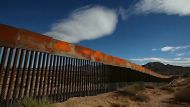The United States dollar's 14-year high is unlikely to abate, despite the protestations of Donald Trump.
The US President jawboned the dollar last week in an interview with The Wall Street Journal, momentarily driving the currency lower with his claims the US dollar was "too high" and "killing" US exports to China.
More World News Videos
Dow takes first-ever leap above 20,000
The Dow surged above the 20,000 mark for the first time in history as a solid earnings season and optimism over possible Trump policies fueled investor optimism.
But the US dollar is strong for good reason, economists said. And unluckily for Mr Trump, the rest of the world is unlikely to help him drive the US currency lower.
In the month following Mr Trump's election, the already-soaring US dollar appreciated a further 4 per cent, according to the US Dollar Index, which measures the currency against a basket of others.

It has since moderated somewhat, but remains at its most valued in over a decade. On Wednesday, as the Dow Jones Industrial Average closed above 20,000 for the first time, the US dollar bought just 1.26 British pounds, and 76 Australian cents.
The key to the US dollar's ongoing strength is, fundamentally, the "rude health" of the US economy, said NAB's global co-head of foreign exchange strategy Ray Attrill.
His view echoes that of yet-to-be-confirmed US Treasury Secretary Steven Mnuchin, who said that "the strength of the dollar has historically been tied to the strength of the US economy and the faith that investors have in doing business in America".
Mr Trump's stated policies, meanwhile, can only further inflate the currency. A cut in the company tax rate would significantly boost the after-tax returns on US equities, encouraging global investment in the US sharemarket, adding demand for the US dollar.

Mr Trump's tax plans could also encourage American multinational corporations to move profits out of tax havens back to home soil, further driving the US economy.
Meanwhile, policies such as a Border Tax – a policy mooted among House Republicans that would apply border tariffs on imported goods while offering tax incentives to American exports – would add to demand for the US dollar while decreasing its global supply (incidentally also lowering the cost of imports to America, such is the stabilising effect of floating currencies).
Add in a likely rise in US interest rates, as is widely expected in 2017, and the US dollar will only rise.
On most historical measures, the US dollar is overvalued. It is only slightly above its long-term inflation-adjusted average, when compared to a basket of currencies.
But on the Big Mac Index – a crude measure which assumes the economic theory at identical goods from different parts of the world should cost the same when converted a common currency to examine how under-or-over priced currencies are – the US dollar is severely overvalued against almost all the world's currencies.
In recognition of these dynamics, discussion of what can be done to stem the rise of the greenback have grown in financial circles. Of particular notice has been the possibility of a repeat of the 1985 Plaza Accord – an economic pact agreed to by the world's six richest countries to over several months sell their US currency reserves, addressing the then-strength of the US currency.
It is likely the history lesson will have reached the Oval Office – Dan DiMicco, an adviser to Mr Trump and member of the president's transition team, has written extensively about the Plaza Accord.
A strong US currency does harm many developing nations, particular those with debts denominated in US dollars, who are forced to pay more in their local currency to service their loans. But hopes of the US' major trading partners agreeing to a 'Trump Tower Accord', as hopes of such a policy have been dubbed, are slim.
For the United Kingdom, a relatively weak British currency could help it maintain exports as it pulls out of the European Union. Japan is engaged on a massive reflationary drive, the effect of which has been to lower its currency – it is unlikely to halt this domestically focussed policy for the benefit of the United States. China, meanwhile, has already been chewing through its US currency reserves – to the tune of $US66 billion in November – in a bid to stabilise the renminbi, which has been falling against the US dollar.
"It is hard to imagine the authorities in Europe or Japan backing a weaker dollar, given the relatively poor health of their own economies and the fact that the US current account deficit is less than 3 per cent of GDP," said Capital Economics' Oliver Jones and John Higgins in a briefing note last week.
"The US could try to go it alone. But unilateral intervention without the support of the US' G7 partners would presumably be far less likely to succeed."
Most countries would prefer a lower currency, said Commonwealth Bank chief currency strategist Richard Grace. "But the fact is that the pressure on the US dollar is completely understandable. You've got monetary policy divergence between the US and the rest of the world.
"And strong GDP growth momentum. And recently the US economy returned to a period when net exports started to contribute to GDP growth. It does appear the US economy, with net exports helping GDP, is not feeling the major pinch of a strong US dollar."












